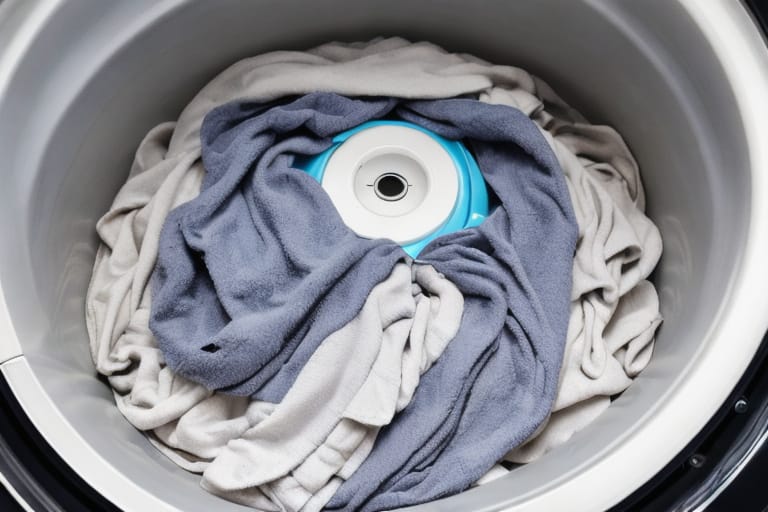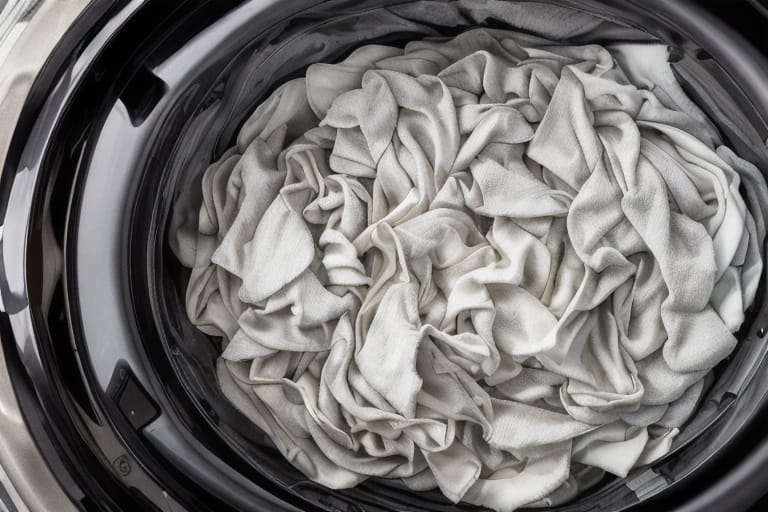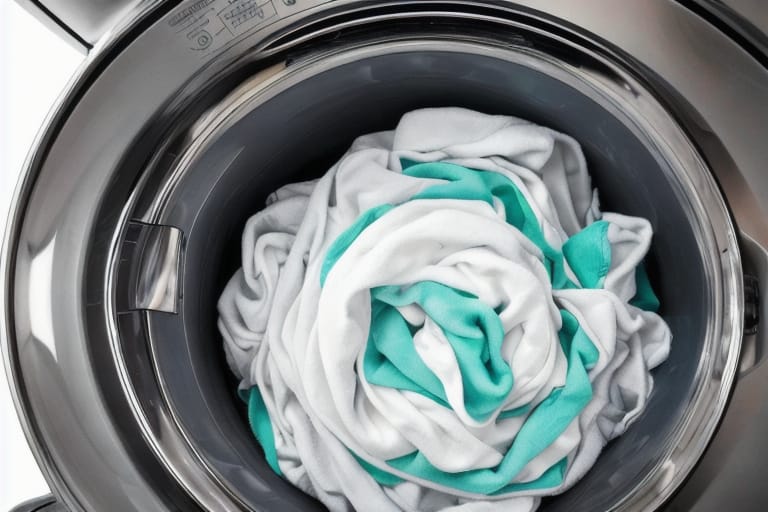Do you love snuggling under the warmth and softness of your down-filled comforter, only to catch an unpleasant whiff redolent of damp canine? You’re not alone. The distinctive wet dog smell emanating from a down comforter strikes many at some unfortunate point.
This common phenomenon typically results from built-up body oils and moisture creating an appealing environment for microbial growth. Thankfully, with some diligent cleaning, drying, storing, and preventative care, you can eliminate the funky odor and enjoy your cozy bedding fresh as new.
What Causes the Wet Dog Smell in Down Comforters
Before detailing the many techniques for banishing odor, let’s explore the reasons a down-filled bed cover develops this signature stench.
Natural Oils and Moisture Buildup
The fill power of down comes from natural oils secreted by ducks or geese. These oils give the down its ability to trap air and provide unmatched insulation.
- Over time, our bodies add skin oils, sweat, and moisture to the mix. This produces an ideal breeding ground for microbes that release stinky metabolic byproducts.
Bacteria and Dust Mites Thrive in Down Bedding
- Bacteria feeds on the natural bird oils and human oils and sweat lodged in the down fill.
- Microscopic dust mites also proliferate in the comforter. Their fecal matter interacts with the oils to create that distinctive odor.
Improper Cleaning and Drying Methods
Care labels on down comforters stress the importance of proper washing methods to preserve insulation and avoid mildew.
- Insufficient drying can leave moisture lingering in the fill along with soap residue. This allows smelly bacteria to flourish again.
- Harsh detergents can strip the natural oils, reducing the bedding’s ability to loft and retain heat.
Why Odor Control Matters
Beyond simply being unpleasant, persistent smells in bedding can impact comfort and health.
Impacts Comfort and Sleep Quality
- Malodors disrupt sleep when the smell permeates the bedroom.
- Discomfort from the odor may lead to tossing and turning or awakening multiple times.
Triggers Allergies and Asthma
- Microbes and dust mites in bedding provoke allergic reactions in those predisposed genetically.
- Asthma flare-ups often result from sensitivity to particles emitted by bacteria accumulating in the comforter.
Best Practices For Washing Down Comforters
Now that we know why wet dog smells plague down bedding, let’s explore the proper techniques to clean comforters for odor elimination.
Use a Front-Loading Washing Machine
- Front-load washers provide the most thorough cleaning of down with less stress on the stitching. The horizontal tub rolls clothes over gently for uniform soaking.
- {{Bold}} Top-loaders {{Bold}} can damage the baffles keeping down evenly distributed. The central agitator is harsh on the fabric and fill.
Wash with Cold Water and Mild Detergent
- Always use cold water in the washing machine as hot water can shrink fabrics and strip insulation oils from the down.
- Choose a mild detergent designed for fine washables. Don’t use bleach or fabric softener which leaves residue in down.
- Add a specially formulated {{Bold}}down wash{{Bold}} that contains enzymes and cleaning agents tailored for feathers.
| Product | Price | Rating |
|---|---|---|
| Norwex Ultra Power Plus Laundry Detergent | $19.99 per bottle | 4.9/5 |
| Nathan Sports Wash Laundry Detergent | $11.50 per bottle | 4.7/5 |
| Down Wash from The Laundress | $16 per bottle | 4.8/5 |
Rinse Thoroughly and Air Dry Fully
- Rinse the comforter two or three times after washing, using cold water. This removes all traces of detergent which can cause skin irritation or trigger allergies if residues linger.
- Air dry completely before storage or remaking the bed. Any lingering dampness allows odor-causing bacteria to regenerate.

Best Practices For Drying Down Comforters
Proper drying is key to preventing bacterial growth after washing down comforters.
Machine Dry Using Low Heat
Add 2-3 clean tennis balls to break up clumps. The balls bounce around gently to fluff fill. (Note: Only use new balls never used outdoors. Used balls can introduce mildew spores from grass and soil.)
Set dryer to low or no heat. High heat risks shrinking or scorching the delicate fabric.
Examine periodically to feel for dryness. Over-drying causes brittleness.
Line Dry Outdoors
This allows fresh air circulation for a fully clean scent. Hang over a clothes line or drying rack, periodically fluffing to expose any hidden moist patches.
Storing Down Comforters Properly
Sanitize the storage space fully before placing clean, dried bedding inside.
Use Breathable Cotton Storage Bags
- Cotton canvas allows air circulation while protecting from dust and pests
- Plastic tubs or vinyl bags trap moisture so avoid these
Store in Cool, Dry Area
- Attics and basements often get too humid so choose an interior closet
- Maintain temperatures between 60-75°F to inhibit microbes
Periodically Air Out
- Every few months, remove the comforter and allow to air out before returning to storage
- This prevents musty closed-in smells from developing
Specialty Cleaning Solutions
For set-in odors, or as part of periodic deep cleaning, consider adding specialty solutions.
White Distilled Vinegar
- Acidity kills bacteria and lifts residues missed by detergents
- Add 1 cup white vinegar during rinse cycle
Enzyme Cleaners
Specially formulated pet odor removers use enzymes to digest the chemical compounds causing smells. These break down urine, feces, vomit, and sweat residues.
| Product | Price | Rating |
|---|---|---|
| Angry Orange Pet Odor Eliminator | $19.97 per gallon | 4.8/5 |
| Bubba’s Super Stinker Pet Odor Remover | $18.99 per quart | 4.9/5 |
Should You Dry Clean Down Comforters?
Most manufacturers actually recommend against dry cleaning down comforters. The chemicals used can strip oils or leave residue in the down.
However, dry cleaning does eliminate oils and kill dust mites. So for severe odor issues, a thorough dry cleaning may be warranted.
- Search for an environmentally friendly dry cleaner that uses {{bold}}liquid CO2{{bold}} instead of harsh solvents. This deep cleans without damage.
- Air out thoroughly after cleaning to prevent musty closed-in smells.
Maintaining Freshness Long Term
Prevention is key to avoid frequent washing and drying required to remove odors.
Encase in a Protective Duvet Cover
- A snug-fitting, zip-close cover shields from body oils
- Duvet covers allow easy removal for washing
Wash Comforter Every 6 Months
- Frequent washing in cold water with mild detergent keeps oils and microbes at bay
- Stick to delicate cycles and air dry fully
Fluff and Rotate Weekly
Gently shake and redistrubute fill to aerate. Flip top to bottom to evenly distribute body oils.

Frequency Asked Questions
What causes my down comforter to smell like wet dog?
The wet dog smell comes from a build up of body oils, sweat, and moisture that breed odor-causing bacteria and dust mites in the down fill. Their metabolic processes and waste products create the unpleasant damp doggy odor.
How do I get the smell out of my down comforter?
Wash in cold water on a gentle cycle using a mild detergent. Be sure to rinse thoroughly 2-3 times. Machine dry on low heat or line dry fully in fresh air. Severe odors may require an enzyme cleaner or vinegar rinse to fully eliminate smells.
How often should I wash my down comforter?
To prevent future odors, wash down comforters at least every 6 months. For active use during sweaty seasons or by those prone to body oils, wash quarterly. Monthly washings are ideal but may decrease longevity of the feathers.
Can I dry clean my down comforter?
Most manufacturers advise against dry cleaning which uses harsh chemicals. However, in some cases of severe, set-in odor, dry cleaning with liquid CO2 instead of solvents can effectively eliminate smells without damage.
How should I store my down comforter to prevent smells?
After fully air drying, store the freshly washed comforter in a breathable cotton storage bag in a cool, dry place. Avoid plastic containers which trap moisture and odors. Periodically remove and air out the comforter.








